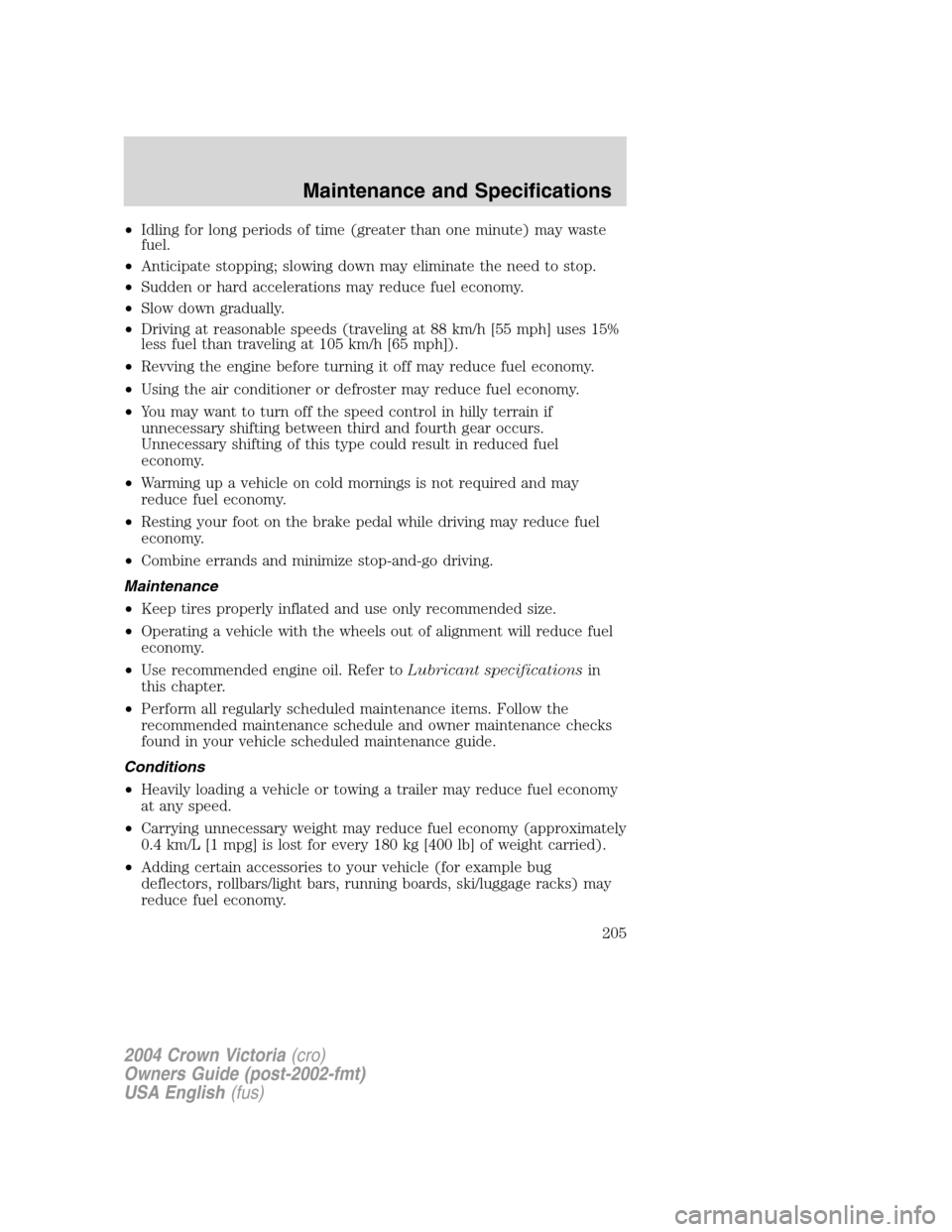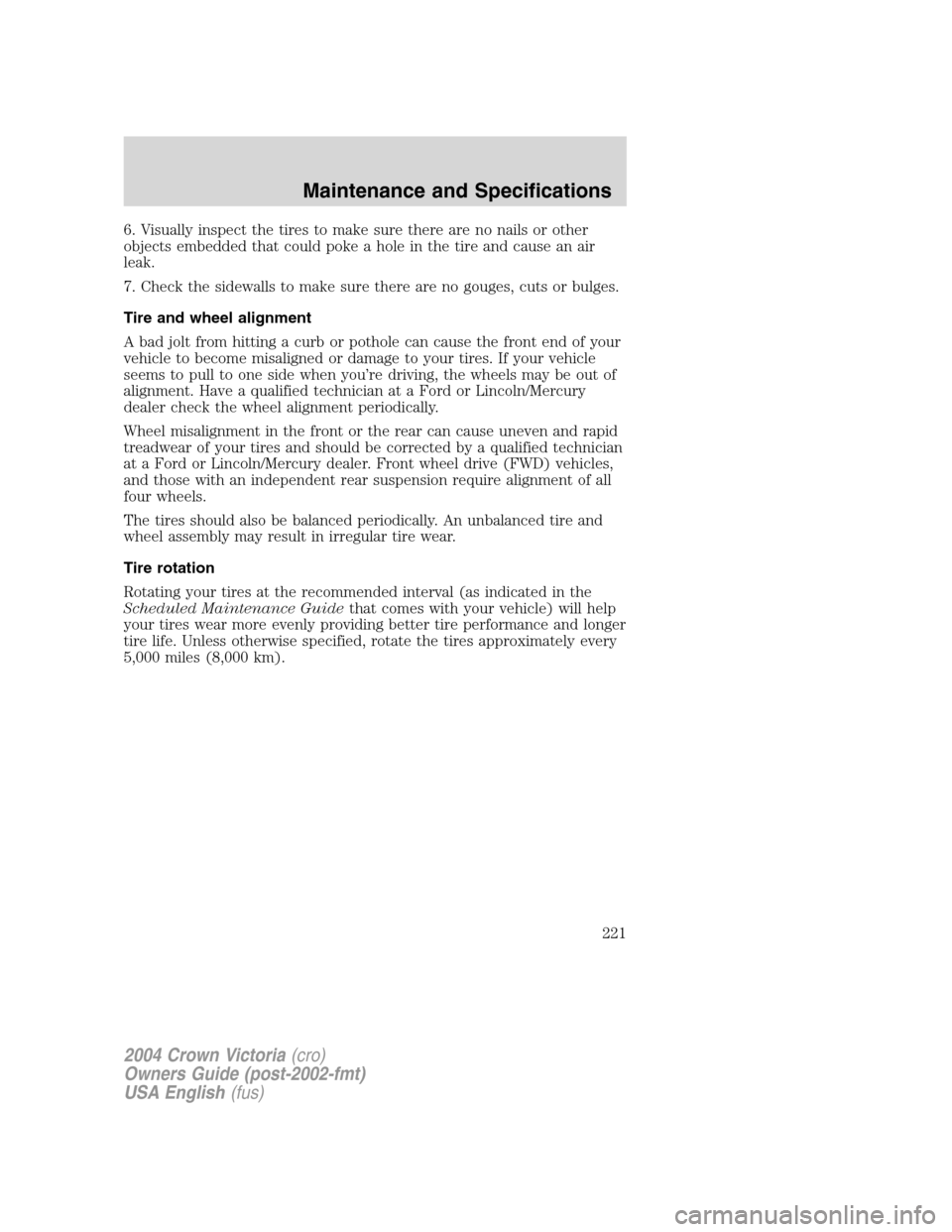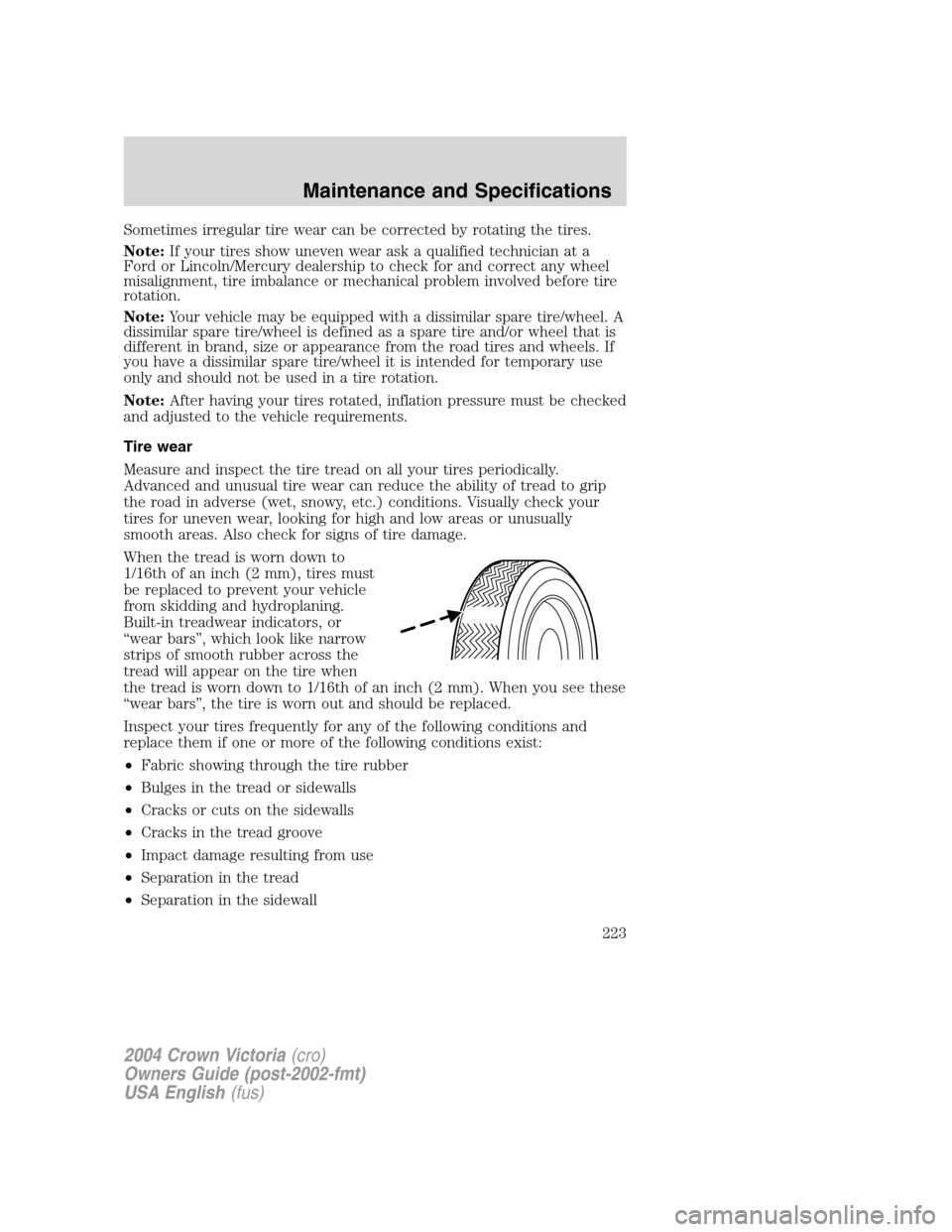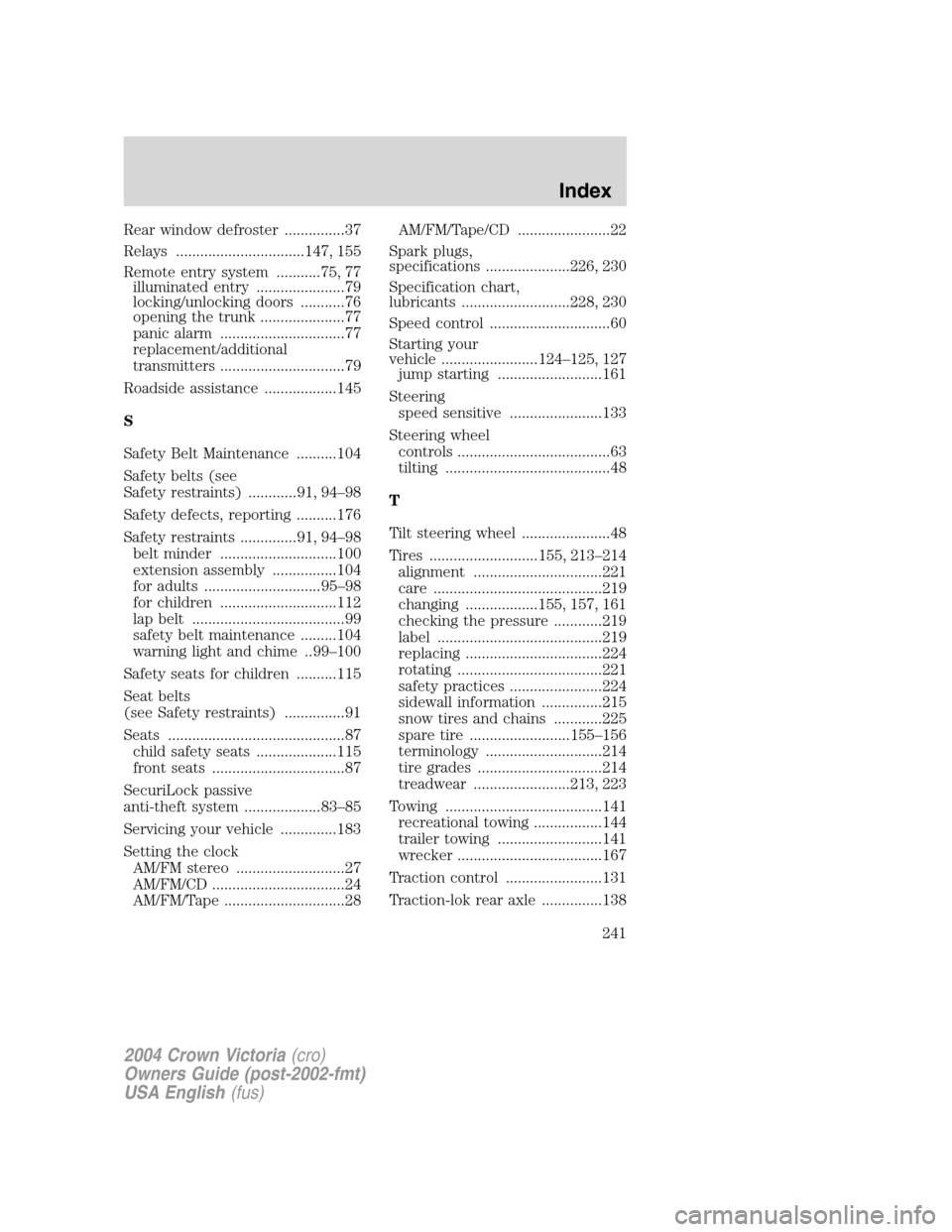2004 FORD CROWN VICTORIA wheel alignment
[x] Cancel search: wheel alignmentPage 205 of 248

•Idling for long periods of time (greater than one minute) may waste
fuel.
•Anticipate stopping; slowing down may eliminate the need to stop.
•Sudden or hard accelerations may reduce fuel economy.
•Slow down gradually.
•Driving at reasonable speeds (traveling at 88 km/h [55 mph] uses 15%
less fuel than traveling at 105 km/h [65 mph]).
•Revving the engine before turning it off may reduce fuel economy.
•Using the air conditioner or defroster may reduce fuel economy.
•You may want to turn off the speed control in hilly terrain if
unnecessary shifting between third and fourth gear occurs.
Unnecessary shifting of this type could result in reduced fuel
economy.
•Warming up a vehicle on cold mornings is not required and may
reduce fuel economy.
•Resting your foot on the brake pedal while driving may reduce fuel
economy.
•Combine errands and minimize stop-and-go driving.
Maintenance
•Keep tires properly inflated and use only recommended size.
•Operating a vehicle with the wheels out of alignment will reduce fuel
economy.
•Use recommended engine oil. Refer toLubricant specificationsin
this chapter.
•Perform all regularly scheduled maintenance items. Follow the
recommended maintenance schedule and owner maintenance checks
found in your vehicle scheduled maintenance guide.
Conditions
•Heavily loading a vehicle or towing a trailer may reduce fuel economy
at any speed.
•Carrying unnecessary weight may reduce fuel economy (approximately
0.4 km/L [1 mpg] is lost for every 180 kg [400 lb] of weight carried).
•Adding certain accessories to your vehicle (for example bug
deflectors, rollbars/light bars, running boards, ski/luggage racks) may
reduce fuel economy.
2004 Crown Victoria(cro)
Owners Guide (post-2002-fmt)
USA English(fus)
Maintenance and Specifications
205
Page 221 of 248

6. Visually inspect the tires to make sure there are no nails or other
objects embedded that could poke a hole in the tire and cause an air
leak.
7. Check the sidewalls to make sure there are no gouges, cuts or bulges.
Tire and wheel alignment
A bad jolt from hitting a curb or pothole can cause the front end of your
vehicle to become misaligned or damage to your tires. If your vehicle
seems to pull to one side when you’re driving, the wheels may be out of
alignment. Have a qualified technician at a Ford or Lincoln/Mercury
dealer check the wheel alignment periodically.
Wheel misalignment in the front or the rear can cause uneven and rapid
treadwear of your tires and should be corrected by a qualified technician
at a Ford or Lincoln/Mercury dealer. Front wheel drive (FWD) vehicles,
and those with an independent rear suspension require alignment of all
four wheels.
The tires should also be balanced periodically. An unbalanced tire and
wheel assembly may result in irregular tire wear.
Tire rotation
Rotating your tires at the recommended interval (as indicated in the
Scheduled Maintenance Guidethat comes with your vehicle) will help
your tires wear more evenly providing better tire performance and longer
tire life. Unless otherwise specified, rotate the tires approximately every
5,000 miles (8,000 km).
2004 Crown Victoria(cro)
Owners Guide (post-2002-fmt)
USA English(fus)
Maintenance and Specifications
221
Page 223 of 248

Sometimes irregular tire wear can be corrected by rotating the tires.
Note:If your tires show uneven wear ask a qualified technician at a
Ford or Lincoln/Mercury dealership to check for and correct any wheel
misalignment, tire imbalance or mechanical problem involved before tire
rotation.
Note:Your vehicle may be equipped with a dissimilar spare tire/wheel. A
dissimilar spare tire/wheel is defined as a spare tire and/or wheel that is
different in brand, size or appearance from the road tires and wheels. If
you have a dissimilar spare tire/wheel it is intended for temporary use
only and should not be used in a tire rotation.
Note:After having your tires rotated, inflation pressure must be checked
and adjusted to the vehicle requirements.
Tire wear
Measure and inspect the tire tread on all your tires periodically.
Advanced and unusual tire wear can reduce the ability of tread to grip
the road in adverse (wet, snowy, etc.) conditions. Visually check your
tires for uneven wear, looking for high and low areas or unusually
smooth areas. Also check for signs of tire damage.
When the tread is worn down to
1/16th of an inch (2 mm), tires must
be replaced to prevent your vehicle
from skidding and hydroplaning.
Built-in treadwear indicators, or
“wear bars”, which look like narrow
strips of smooth rubber across the
tread will appear on the tire when
the tread is worn down to 1/16th of an inch (2 mm). When you see these
“wear bars”, the tire is worn out and should be replaced.
Inspect your tires frequently for any of the following conditions and
replace them if one or more of the following conditions exist:
•Fabric showing through the tire rubber
•Bulges in the tread or sidewalls
•Cracks or cuts on the sidewalls
•Cracks in the tread groove
•Impact damage resulting from use
•Separation in the tread
•Separation in the sidewall
2004 Crown Victoria(cro)
Owners Guide (post-2002-fmt)
USA English(fus)
Maintenance and Specifications
223
Page 241 of 248

Rear window defroster ...............37
Relays ................................147, 155
Remote entry system ...........75, 77
illuminated entry ......................79
locking/unlocking doors ...........76
opening the trunk .....................77
panic alarm ...............................77
replacement/additional
transmitters ...............................79
Roadside assistance ..................145
S
Safety Belt Maintenance ..........104
Safety belts (see
Safety restraints) ............91, 94–98
Safety defects, reporting ..........176
Safety restraints ..............91, 94–98
belt minder .............................100
extension assembly ................104
for adults .............................95–98
for children .............................112
lap belt ......................................99
safety belt maintenance .........104
warning light and chime ..99–100
Safety seats for children ..........115
Seat belts
(see Safety restraints) ...............91
Seats ............................................87
child safety seats ....................115
front seats .................................87
SecuriLock passive
anti-theft system ...................83–85
Servicing your vehicle ..............183
Setting the clock
AM/FM stereo ...........................27
AM/FM/CD .................................24
AM/FM/Tape ..............................28AM/FM/Tape/CD .......................22
Spark plugs,
specifications .....................226, 230
Specification chart,
lubricants ...........................228, 230
Speed control ..............................60
Starting your
vehicle ........................124–125, 127
jump starting ..........................161
Steering
speed sensitive .......................133
Steering wheel
controls ......................................63
tilting .........................................48
T
Tilt steering wheel ......................48
Tires ...........................155, 213–214
alignment ................................221
care ..........................................219
changing ..................155, 157, 161
checking the pressure ............219
label .........................................219
replacing ..................................224
rotating ....................................221
safety practices .......................224
sidewall information ...............215
snow tires and chains ............225
spare tire .........................155–156
terminology .............................214
tire grades ...............................214
treadwear ........................213, 223
Towing .......................................141
recreational towing .................144
trailer towing ..........................141
wrecker ....................................167
Traction control ........................131
Traction-lok rear axle ...............138
2004 Crown Victoria(cro)
Owners Guide (post-2002-fmt)
USA English(fus)
Index
241